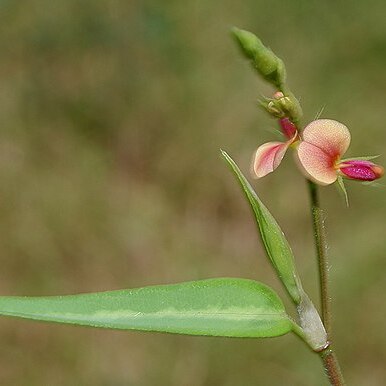Herbs; stems ascending to procumbent, terete, striate. Leaves alternate, 1-foliolate (rarely 3-foliolate); leaflets linear-lanceolate to oval, reticulate-venose; stipules scarious, acuminate, free or connate; bistipellate. Inflorescence race-mose, terminal or rarely axillary, bracts scarious, deciduous, pedicels paired, short. Flowers small; calyx 5-lobed, deeply divided, lobes unequal, the upper 2 connate nearly to the apex, glumaceous; corolla reddish purple, or rarely orange; the standard obovate to orbicular, clawed; the wings obliquely oblong; the keel slightly incurved, obtuse; stamens 10, diadelphous, upper connate only basally; anthers uniform; ovary sessile or shortly stipitate; ovules numerous; style fili-form, incurved at the apex, stigma broadly capitate, terminal. Fruit a loment, terete to compressed, submoniliform, indehiscent; seeds suborbicular or globose, smooth, lustrous, estrophiolate. Chromosomes: n = 8, 10.
Herbs, perennial. Stems erect or diffuse, branched. Leaves 1-foliolate, rarely pinnately 3-foliolate, stipulate and stipellate; stipules scarious or nearly leathery, free or connate. Racemes axillary or terminal; flowers small, mostly ca. 5 mm, usually binate at each node of rachis; bracts scarious, early deciduous. Calyx 4-lobed; lobes dry, rigid, nearly equal, upper lobe 2-toothed at apex. Corolla not or slightly longer than calyx; standard broad, obovate or nearly orbicular; keel obtuse, adherent to wings. Stamens diadelphous (9+1); anthers uniform. Ovary sessile or nearly so, many ovuled; style linear, incurved; stigma capitate. Legume cylindric, swollen, many jointed, 1-seeded per article, indehiscent.
Fruit linear-oblong, at least in outline, mostly several-jointed, the margins straight or the fruit constricted between the segments (articles), which are indehiscent, compressed, subcylindrical or rounded, mostly with a raised reticulation of ridges.
Corolla small, mostly pinkish or purplish; standard ovate, rounded or obovate, produced into a claw, with 2 small longitudinal folds near the base inside; wings obliquely oblong, adhering to the keel, the petals of which are often appendaged.
Calyx scarious, persistent, appearing 4-lobed, the lobes subequal, striate, the upper lobe entire or slightly 2-fid, consisting of the 2 upper calyx teeth entirely or almost entirely connate.
Inflorescences terminal, axillary or leaf-opposed, falsely racemose or less often paniculate, the flowers mostly paired; bracts scarious, at length falling; bracteoles absent.
Leaves 1-foliolate, less often pinnately 3-foliolate; petiole channelled, winged; stipules scarious, acuminate, persistent, free or connate; stipels present, persistent.
Ovary sessile or shortly stipitate, with several to many ovules; style filiform, incurved at the apex; stigma broadly capitate.
Vexillary stamen free in the fully developed flower; free parts of the filaments alternately long and short; anthers uniform.
Seeds subglobose; hilum minute, without a rim-aril.
Annual or perennial, erect or decumbent herbs.

